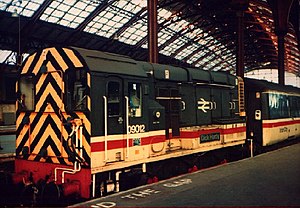British Rail Class 09
| British Rail Class 09 | |||||||||||||||||||||||||||||||||||
|---|---|---|---|---|---|---|---|---|---|---|---|---|---|---|---|---|---|---|---|---|---|---|---|---|---|---|---|---|---|---|---|---|---|---|---|
 09012 at Brighton station | |||||||||||||||||||||||||||||||||||
| |||||||||||||||||||||||||||||||||||
| |||||||||||||||||||||||||||||||||||
| |||||||||||||||||||||||||||||||||||
| |||||||||||||||||||||||||||||||||||
The British Rail Class 09 is a class of 0-6-0 diesel locomotive designed primarily for shunting but also short distance freight trips along branch lines. [1] For this reason, though similar to the existing Class 08 shunting locomotives, Class 09 were re-geared to give a maximum top speed of 27.5 mph (44 km/h) at the expense of a lower tractive effort. They originally operated in the Southern Region of British Railways, though following privatisation, in 1997 they have been distributed much further afield.
Technical details
- Diesel engine: English Electric 6 cylinder, 4-stroke, 6KT
- Main generator: EE 801
- Traction motors: 2 x EE 506 motors with double reduction gear drive
Sub-classes
Class 09/0
The originals became sub-class 09/0 when further locomotives from Class 08 were modified in 1992 to form Classes 09/1 and 09/2. There were variations, which were given the following TOPS design codes:
- 09-0AX Original design; 50.4 te (502 kN); dual brakes
- 09-0BA 51 te (510 kN), air brakes; RA6, knuckle couplings fitted [09003/11]
Classes 09/1 & 09/2
These locomotives were modified from Class 08 in 1992. TOPS numbers were 09 101 – 09 107 and 09 201 – 09 205. The design codes were as follows:
- 09-1AX 110 V electrical system; 50.4 te (502 kN); dual brakes; formerly 20 mph (32 km/h) locomotive
- 09-1BX 110 V electrical system; 50.4 te (502 kN); dual brakes; formerly 15 mph (24 km/h) locomotive
- 09-1CX 110 V electrical system; 49 te (488 kN); dual brakes; fitted with knuckle couplings
- 09-1EA 110 V electrical system; 51 te (508 kN); air brakes; RA6; fitted with knuckle couplings
- 09-2AA 90 V electrical system; 49.6 te (494 kN); air brakes
- 09-2BX 90 V electrical system; 50.5 te (503 kN); dual brakes
- 09-2DA 90 V electrical system; 51 te (508 kN); air brakes; RA6; fitted with knuckle couplings
Operation
Although not normally considered for passenger work, Class 09s were recorded working passenger trains between Clapham Junction and Kensington Olympia due to unavailability of the booked Class 33 diesel.[1]
References and sources
References
- ^ Lund, E (1980). To the last drop. Chesterfield: Longden technical Publications. ISBN 0 9507063 0 2.
Sources
- Marsden, Colin J. (1981). Motive power recognition:1 Locomotives. Shepperton: Ian Allen Ltd. ISBN 0 7110 1109 5.
External links
- Spa Valley Railway - Operators of 09004
- SEMG gallery
- EPB Preservation Group - Operators of 09025
